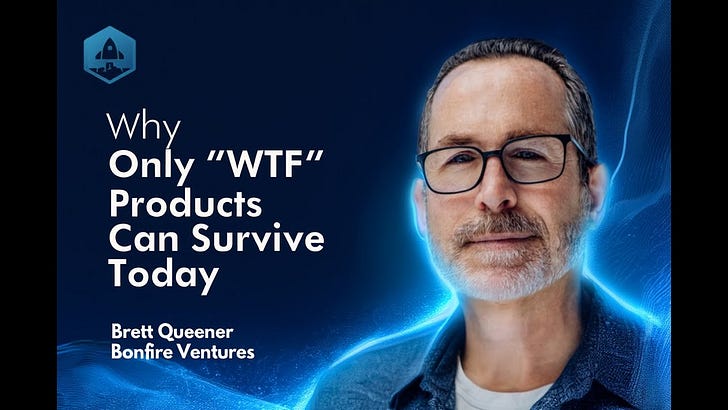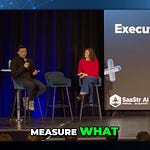Ahead of SaaStr AI London on Dec 1-2 (See you there!) we’re taking a look back at some of our favorite sessions from our European events. It was so great when Olivier Pomel, founder CEO of Datadog, joined us as they crossed $100,000,000 ARR in a candid conversation it would be harder to do today post-IPO.
The First $100,000,000 ARR at Datadog: How Olivier Pomel Built a Customer-Centric Monitoring Giant
From zero lines of code to 700 employees and doubling revenue annually, Datadog CEO Olivier Pomel shares the counterintuitive strategies that built one of the most customer-obsessed companies in B2B SaaS
Olivier’s Top 5 Toughest Learnings
You can’t be customer-focused if you’re sales-driven OR engineering-driven - Most companies fall into one trap or the other. Sales teams optimize for closing the next deal (short-term), while engineering teams build for the long-term without bridging back to customers. Customer-centricity requires daily vigilance against both.
Closed alphas with “perfect customers” give terrible signal - Handpicking the best companies and best people for early access actually makes it harder to learn. Customers need to self-select when the timing is right for them. Open betas revealed infinitely more than curated alphas ever did.
Month-to-month contracts are better than annual deals for learning - Every instinct (and investor) tells you to sell annual contracts. But monthly contracts force bad news to surface immediately instead of a year later. A year of going in the wrong direction is devastating for a young company.
There’s no MVP for enterprise infrastructure - The conventional wisdom about shipping minimal products doesn’t apply when selling to enterprises who need comprehensive solutions. You need depth across many features before you’re minimally useful. It’s a continuum, not a single viable moment.
Pricing conversations reveal product truth better than any metric - Putting a dollar amount on features focuses customers’ minds like nothing else. When customers say “I won’t pay for that,” you get brutally honest feedback about value. This friction is healthy and teaches you where to go next.
When Olivier Pomel and his co-founder started Datadog in 2010, they didn’t write a single line of code for the first six months. For two engineers itching to build, this took “some restraint,” as Olivier puts it. But this decision to obsessively listen before building became the foundation of a company that would redefine infrastructure monitoring and grow to 700+ employees while doubling in size every single year.
At SaaStr Europa, Olivier pulled back the curtain on how Datadog became one of the most customer-centric companies in enterprise software—and why being truly customer-focused requires constantly fighting against your natural instincts.
The Problem: When Great Teams Hate Each Other
The genesis of Datadog came from a painful problem Olivier and his co-founder experienced firsthand. Despite working together across four different companies, knowing each other extremely well, and building their teams from scratch with a “strict no asshole policy,” they ended up in a familiar nightmare scenario two years in.
“We ended up with developers that hated operations, operations that hated developers, fingerpointing—all of the things that you can imagine,” Olivier explained.
The question became simple: Why don’t we give all of those teams the same viewpoint? How do we get them aligned and understanding their infrastructure the same way?
This became Datadog’s founding mission—bringing DevOps together and bridging the gap between development and operations teams. What they didn’t fully realize at the time was that this wasn’t just a nice-to-have feature. It was actually one of the KEY reasons why companies would migrate from legacy IT to the cloud.
“We ended up right in the center of it,” Olivier said. “Today the company is about 700 people. We’ve been doubling the size of the company every single year. It turns out everybody is moving to the cloud and everybody needs to understand what’s happening to their systems and applications.”
The Counterintuitive Truth About Customer-Centricity
Here’s the part most founders get wrong: you can’t be customer-focused if you let your company become sales-driven OR engineering-driven.
“Everybody wants to be customer-focused,” Olivier noted. “But most companies end up being either sales-driven or engineering-driven. If you want to be customer-focused, you can’t be either of those.”
The Sales-Driven Trap: Sales teams are phenomenal at figuring out what’s going to get a deal done. But very often, getting the next deal done is NOT what you want to do for the long run for your customers. Short-term thinking dominates.
The Engineering-Driven Trap: Let your engineering teams run on their own, and you’ll end up with organizations where people focus way too much on their solutions and way too much on the long term. You’ll struggle to bridge that gap back to the customer.
The solution? “It’s a struggle of every day to make sure that we go back to the customer and start from there.”
This wasn’t a conscious choice at first—it was forced upon them. Starting in New York (not the Bay Area), without Google or Facebook pedigrees, without millions in funding, and without a suite of VCs telling them they were geniuses, Datadog had no choice but to obsessively focus on the problem.
“We basically had to focus on the problem. We spent the first couple of years listening to customers and trying to understand what the problem was.”
The First Two Years: Why They Didn’t Write Code for 6 Months
When you’re engineers and you start a company, every instinct tells you to build. Olivier and his co-founder resisted this for six months—and discovered something remarkable.
When you don’t have anything to sell, everybody is super happy to talk to you.
“You’ll get hours and hours of really fantastic people at fantastic companies and they’ll spend all that time explaining to you what their problems are, what’s working, what’s not working for them. They’ll be extremely candid.”
This changes the moment you have something to sell. “Then you’re tainted. You have too much of a vested interest and you’re trying to push something, so people won’t open up so easily.”
After six months of research, they spent another six months building their first alpha. When they deployed it to a small number of customers, they noticed the product was “way too open-ended, way too general.”
But here’s where they made a critical discovery that contradicts conventional wisdom about customer selection.
The Open Beta Revelation: Let Customers Self-Select
Datadog initially ran a closed alpha, handpicking the best companies and the best people at those companies. “It was actually really, really hard to get a lot of signal from these customers,” Olivier admitted.
Then they opened it up to a wide beta—and everything changed.
“It’s a lot easier for users to self-select and start using your product than for you to understand for whom you’re going to be the right thing at the right time.”
You can’t predict when customers will have free bandwidth, when all the stars will align for deployment, or when your solution will be exactly what they need. Let them tell you by trying it.
This open approach became core to Datadog’s growth strategy and fed directly into their customer-centric philosophy.
Why Datadog Doesn’t Believe in MVPs
Ask most SaaS founders about MVPs and you’ll get textbook answers about shipping fast and iterating. Olivier has a different take.
“I don’t think there’s an MVP for what we do. I think it’s a myth,” he stated bluntly.
Here’s why: Datadog sells to enterprises. They sell a product that needs to monitor everything happening across entire infrastructures and applications. There’s a very large number of features customers rely on, and none of these features in themselves are revolutionary.
“You need to have them, otherwise you cannot be minimally useful. It’s more of a continuum—you keep adding those features, and at certain point you have enough of them that customers can start buying.”
The hard part? Figuring out which features matter most. “That’s why you have to go back to the customer and make sure you have enough of them so you can actually extract some signal from those conversations.”
For enterprise B2B infrastructure companies, the MVP concept often doesn’t apply. You need depth before customers will even consider you.
Scaling Customer-Centricity: The 10-100 Person Phase
When Datadog hit the market, they were about 10-15 people. The phase of reaching initial scale ran from there to just under 100 people. This is where most companies start to lose their customer focus—but it’s also where you can build the most powerful feedback mechanisms.
Strategy #1: Only Sell Month-to-Month Contracts
“We didn’t sell yearly deals for a very long time. We only sold month-to-month, meaning customers had the opportunity to churn all the time.”
This was structural, not accidental. If something is wrong with the product, if you don’t solve the right problem, if it’s not valuable enough—you know right away. Customers churn and you can have a conversation with them.
“If you start selling term deals, you’re going to have the bad news about a year later. By then you’ve wasted a year. You’ve gone in the wrong direction. You’ve made all these mistakes you could avoid otherwise.”
The lesson: Find structural ways to get bad news quickly. Don’t let long-term contracts mask product problems.
Strategy #2: Put Every Engineer on Support Rotation
Every single engineer at Datadog goes on a one-week support rotation throughout the year. Not just professional support engineers—every engineer in the company.
“Engineers are super happy when it starts, and they’re even happier when it ends,” Olivier joked. “But really what it gives is empathy for the customer.”
Engineers see what problems customers face day-to-day. They see the consequences of their design choices. Sometimes features that seemed like fantastic ideas turn out to be confusing from the customer’s perspective.
“It was a great idea, but we’re going to change it because it doesn’t work quite as well.”
Strategy #3: Bring Engineers to Conferences to Give Demos
Datadog does extensive event marketing because companies migrating to the cloud need to go to conferences to learn. They exhibit at these conferences, give lots of demos—and they bring engineers to do all of it.
“Everybody’s on a rotation and everybody’s going to get to one, two, three, five maybe of those conferences and spend every time a full day basically giving demos to potential customers or existing customers and answering questions.”
This builds empathy for customers and makes the whole engineering team more confident about the problems they’re solving and their relationship to end users.
But here’s the trick: Many engineers aren’t naturally comfortable seeking strangers’ attention at a booth for hours. The solution? Have other people on the team responsible for getting attention and introducing visitors to engineers. Then engineers can settle into a rhythm of demos and questions without the anxiety of having to attract people.
What Metrics Actually Matter (and Which Ones Don’t)
Here’s something counterintuitive from a company that processes 4-5 trillion customer metrics per day: Datadog isn’t incredibly metrics-driven for their own product.
“Most of the metrics are lagging indicators and they don’t convey all the nuance of the value that our customers are going to find with our product. So we don’t actually train ourselves to optimize to the metrics.”
What they DO watch:
Volume of data and infrastructure customers are monitoring: A sign of the value they’re providing, because customers deploy them into more places
Engagement: But this isn’t revolutionary
Churn: Which is why they focused on month-to-month contracts early on
The philosophy: Don’t let metrics become a substitute for actual customer conversations and understanding.
Scaling to 700: When Everything Changes
At 700 people across 16 offices worldwide, some of the early strategies don’t work anymore. The executive team can’t meet with all customers all the time. The co-founders and CPO can’t do all the product work.
This is where Datadog made a critical hire: product managers.
But not just any product managers. They didn’t hire their first PM until they were over 100 people, and when they did, they defined the role very specifically.
“Product managers are not here to invent product. They’re here to spend the most time possible with the customers outside of the office.”
Their job:
Understand what customers’ problems are
Understand what they’re using, what they’re not using
Understand what they’re paying for and why
Get the best understanding possible of the problem and the value those problems represent
Present the product and get feedback
“Their role is not to invent the product but to make sure it solves the right problem and has the right value.”
This is a fundamentally different view of product management than most companies have. PMs aren’t visionaries sitting in a room designing the future—they’re customer researchers and feedback conduits.
The Startup-Within-a-Startup Problem
When you start branching into new products or new markets, you’re suddenly back in startup mode—and it’s easy not to realize it.
“It’s easy to get used to winning, and then you expect everything’s just going to work this way,” Olivier explained.
Teams working on new products need to behave exactly as you would when you were a tiny company:
Soliciting as much feedback as quickly as possible
Going as wide as possible with betas
There’s tension here. You don’t want to taint the opinion of your existing product by releasing a new product that isn’t as polished. But if you want that new product to work, you need to go very wide very quickly.
Most importantly, you need to create a culture where people seek the bad news.
“It’s much better to go to a customer and ask them, ‘This new product—are you going to pay for it? You’ve tried it. Is it good enough? Are you going to buy it?’ It’s actually much better to hear from them, ‘No, I’m not going to buy it, and this is why,’ than to kick the can down the road and hope that maybe in 3 months, 6 months, 9 months they’ll change their mind.”
When you know what’s not working, it gives you a thread to pull. It tells you where you need to go.
The Counterintuitive Truth About Pricing
Here’s where customer-centricity gets tested: the pricing conversation. Customers want to spend as little as possible. You want them to pay as much as possible. How do you stay aligned?
First, agree on what kind of company you are. Olivier sees two types:
Type 1: Low-End Disruptors The major feature is that it’s cheaper. The dynamic with customers is they’ll push you to be cheaper and cheaper and to figure out what you can take out of your product so it can be as cheap as possible.
Type 2: High-Value Products You charge more for your product and you have to deliver more value for that. The cycle with your customer is to deliver more and more.
“You have to agree with your customer that they’re looking for high value, high impact—not as cheap as possible—because otherwise you’re never going to meet.”
Once you’ve agreed on that, you’re aligned in the mid and long term. Your customers want you to be successful. They want your company to be in business two years from now. They want you to ship new features. They really want you to be successful.
After that, there’s still friction—but that friction is how you learn about the value of your product and where you need to go next.
“Asking for money and putting a dollar amount on the product really focuses the mind for the customers. It helps you get really, really good feedback on where you need to go. In the long run, it’s a very healthy relationship to have.”
The key insight: See your customer as a partner. Frame it as “Let’s do this together. You want me to succeed and I want you to succeed, and the commitment on your side is to pay.”
How Olivier Maintains Culture at 700 People
Culture isn’t about writing down seven values on a wall (though Olivier says they’ll do that eventually as they continue to scale). Culture is really about who you hire, who you fire, and who you promote.
To maintain a customer-centric culture at scale, Datadog trains managers to care about the details. Olivier himself still sees every single customer complaint and support email that comes in.
“I don’t read most of them. I delete most of them right away. I just scan them very quickly. But what this does is it helps me pattern match. It gives me a sense of what’s actually happening, how people are actually reacting to the product, what they’re saying.”
He never acts on them directly. He never goes back to the customer or tries to solve the problem. But if he wants to affect change, he goes back through the management chain to make sure people get feedback and decide whether they need to change something.
The other critical element: Be super careful about how you talk about customers inside the company.
In sales, it can be tempting to talk about customers in manipulative ways as you try to manage them through a process. In engineering or product, you can think customers are making the wrong choices—”Why are they doing this stupid thing with our product?”
“The way we see it is if they’re doing a stupid thing with our product, it’s our fault. We let them do that. We made them think they should be doing that, or we didn’t explain it right.”
Always assume the customer is right. And even if you think they’re wrong, the fact that they’re thinking something wrong is itself a fact. It exists. You have to deal with it and you have to value it.
You can’t let yourself dismiss what you hear from customers.
The Acquisition Test: Optimizing for After the Deal
Datadog has made two acquisitions, both heavily tilted toward the tech platform, product, and team—not revenue streams to add to their sales engine.
“What we optimize for is what’s going to happen after we close the deal. Are people going to stick around? How long are they going to stick around? Are we going to be able to build on top of that team and turn that team of 20 we just acquired into a department of the company that’s going to have 200, 500 people?”
It’s all optimized on the fit and what happens after the acquisition—whether the companies share the same values.
The One Piece of Advice: Run Toward the Bad News
If there’s one principle that runs through everything Datadog does, it’s this:
“Really look for the bad news. Run toward the bad news.”
Whether you just shipped the product or you’re renewing a big customer, the wrong thing to do is show up in front of the customer hoping they won’t bring up the issue in the account. “Hey, maybe with a bit of luck we can get away with it.”
“Actually no—the first thing you do is you talk about it. You bring it up. Then you hear directly from the customer what they have to say about it. It actually goes a long way toward building the partnership, and it also helps you learn from the conversation with your customers.”
This applies at every stage:
First six months: Don’t build—just listen to bad news about the market
Alpha stage: Open it up to get bad news faster
Launch phase: Only sell month-to-month so bad news comes immediately
Scale phase: Put engineers in support so they hear bad news directly
New products: Ask customers point-blank if they’ll pay for it
Big renewals: Lead with the problems
The Bottom Line
Building a customer-centric company isn’t about being nice or having good intentions. It’s about building structural mechanisms that force bad news to surface quickly and loudly.
It’s about resisting the natural pull toward being sales-driven (short-term thinking) or engineering-driven (disconnected from reality).
It’s about spending six months not coding when you’re itching to build.
It’s about letting customers self-select rather than trying to control who uses your product.
It’s about putting engineers in uncomfortable situations where they have to face customers directly.
It’s about only selling month-to-month when your investors want annual deals.
It’s about asking customers if they’ll pay for something and being ready to hear “no.”
From zero to 700 people and doubling revenue every year, Datadog’s growth came from one counterintuitive principle: The best way to win is to constantly seek out why you might be losing.
“You have to the wrong thing to do is hope the customer won’t bring up the issue,” Olivier concluded. “The first thing you do is you talk about it. You bring it up. Then you hear directly from the customer what they have to say about it.”
That’s customer-centricity at scale.
Olivier’s Top 5 Mistakes (In His Own Words)
Running a closed alpha with handpicked customers - “It was actually really, really hard to get a lot of signal from these customers.” Trying to control who got early access and picking the “perfect” companies backfired. Opening up the beta was when everything changed.
Building the first alpha too open-ended and general - “We noticed that the product was not exactly what it needed to be. It was way too open-ended, way too general.” Even after six months of customer research, they still got the scope wrong initially.
Not realizing how big the cloud opportunity would be - “We didn’t quite understand at the time that the cloud was going to be so big. We thought, hey, looks cool, why don’t we build it for companies moving to these new cloud environments.” They underestimated the magnitude of the shift they were riding.
Not understanding that DevOps bridging was the killer feature, not just a feature - “We didn’t quite realize was that bringing DevOps together, bridging those two teams, was not just a feature of the new world. It was actually one of the key reasons why companies would be moving from legacy IT to the cloud.” They had the solution before they understood its full strategic value.
Almost letting new products follow the old playbook instead of startup mode - “It’s easy to get used to winning and then you expect everything’s just going to work this way.” When launching new products at scale, they had to consciously fight against the temptation to skip the scrappy early-stage customer validation work that made them successful in the first place.
Want more insights on building customer-obsessed B2B + AI companies? Join us at the next SaaStr AI London Dec 1-2, where founders and CEOs share the unfiltered truth about scaling from $0 to $100M ARR and beyond.








